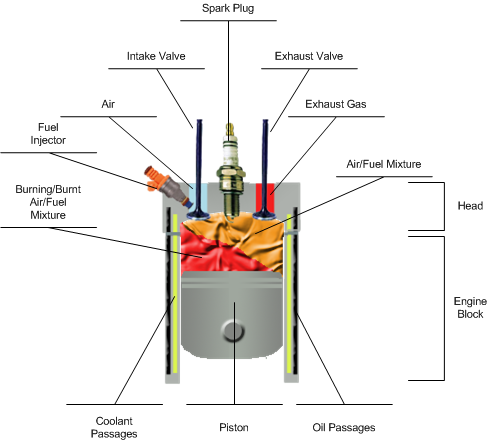
Spark Plug
When this receives around 20k volts, a spark is produced and causes the Air/Fuel mixture to ignite, pushing the piston downwards.
Intake Valve
The Camshaft, a.k.a. Bump Stick, opens and closes this valve for each cylinder independently. When this valve is opened,
atmospheric air is drawn into the cylinder due to the piston moving down.
Exhaust Valve
The Camshaft, a.k.a. Bump Stick, opens and closes this valve for each cylinder independently. When this valve is opened,
burnt air/fuel gases are pushed out of the cylinder due to the piston moving up.
Air
This literally is just atmospheric air.
This comment will cause concern with people who are familiar with carbureted engines.
This is because in carbureted engines, the intake manifold contains an air/fuel mixture,
but in fuel injected engines, this is not the case.
In fuel injected engines, the intake manifold contains atmospheric air.
Exhaust Gas
The air/fuel mixture is ignited by the spark plug, and this is the remains of that process.
Fuel Injector
The Powertrain Control Module, PCM, turns this actuator on and off. When this actuator is on, fuel is sprayed past the open intake valve
converting the air in the cylinder into an air/fuel mixture. Note: To meter the amount of fuel in the cylinder, the PCM controls how
long this actuator is on.
Air/Fuel Mixture
The Powertrain Control Module, PCM, controls the actual Air to Fuel ratio comprising this mixture. Generally, for best tail pipe
emissions, the PCM sets this ratio to 14.7:1 ( air parts : fuel parts ). If the PCM is trying to extract more power from the engine,
this ratio is around 12:1 or is trying to extract more economy from the engine, this ratio is around 16:1.
Burnt Air/Fuel Mixture
Once the spark plug ignites the Air/Fuel Mixture, this burning process transforms the Air/Fuel Mixture into the Burnt Air/Fuel Mixture
ending with it becoming Exhaust Gas.
Coolant Passages
The Engine Block and Cylinder Head contain vein like passages used to move Coolant through it. As the Coolant moves through these
veins in the metal, the Coolant is extracting heat from the metal, which reduces the heat in the metal.
Oil Passages
The Engine Block and Cylinder Head contain vein like passages used to move oil through it.
As the oil moves through these veins, drilled out ports
are reached where critical metal on metal components receive much needed oil. In addition, as the oil drips and runs down
back to the oil pan, it is pulling heat from the metal, which reduces the heat in the metal.
Piston
Each piston is connected to the crankshaft via connecting rod. These two later components are not
included in this diagram and will be discussed later. The Crankshaft is connected to the Transmission which then delivers
this energy to the tires. So, as the ignited Air/Fuel mixture expands, it pushes the piston down away from the head, which results
in the Crankshaft receiving rotational energy.
Head
This is also called the Cylinder Head. It contains all the components of the valve train, spark plugs, injectors, and sometimes
Camshaft(s).
Block
Often referred to as the Engine Block. It houses most of the parts that make of the internals of the engine.